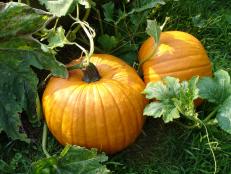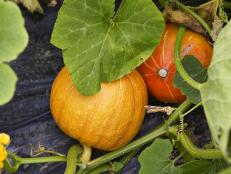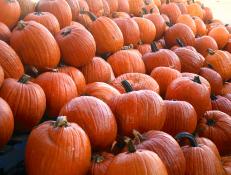How Do Pumpkins Grow?

Maria Uspenskaya / Shutterstock.com
Pumpkins, along with their winter squash cousins, are often referred to as a “garden gorilla” because they are large plants. These vines sprawl and crawl their way through the growing season, gobbling garden real estate. As you watch these plants stake out their territory, you may wonder how do pumpkins grow? Like all plants, it’s a blend of simple ingredients that fuels the growing frenzy: sunshine, water, and carbon dioxide.
The process of photosynthesis provides the oomph behind a pumpkin vine’s enormous growth. Pumpkin leaves convert sunshine, water, and carbon dioxide into food the plant can use to produce leaves, roots, flowers, and pumpkins. Pumpkin plants grow as a vine, which can easily reach 20 to 30 feet long in the course of a growing season. By harvest season, a single hill of jack o’lantern-type pumpkins can cover 50 to 100 square feet.
In a typical suburban backyard, finding room for a full-size pumpkin vine can be challenging. Many gardeners tuck pumpkin plants along the edges of a vegetable garden and direct the vine along the edges of the garden. This works well—just remember to allow entry points into your garden, or you’ll be wading through pumpkin vines to tend your garden.
Pumpkin-palooza! 10 Pumpkin Varieties
See All PhotosAnother option is to allow vines to scramble across your lawn. Continue to mow the grass near pumpkin vines, but take care not to damage vines, leaves, or pumpkins. As the main vine starts to establish its path across the grass, lay out a line of compost three to four inches deep along the vine’s trajectory. Vines grow pretty straight, so it will encounter and follow the compost layer.
As the pumpkin vine grows along this path, the stem will sink secondary roots into the compost, anchoring itself to the lawn. These secondary roots help feed the growing pumpkins. At the end of your pumpkin harvest, pull up the vines, mow the grass, and rake the compost into the surrounding lawn. Overseed the areas where the pumpkin vine ran through the compost. Using this method, the pumpkin vine won’t really damage your lawn. Your turf will be as good as new next spring.
You can avoid the problem of lawn-eating pumpkin vines by choosing varieties that grow in a semi-bush or bush formation. These pumpkins take up less space and produce smaller fruit in a shorter timeframe. Some are true miniatures, but others yield pumpkins in the 10- to 15-pound range. The pumpkins on bush and semi-bush plants often have more concentrated sugars than carving pumpkins, making them a wonderful addition to your kitchen pantry.
A semi-bush pumpkin covers 30 to 35 square feet. Semi-bush plants that yield pumpkins in the 2- to 5-pound range include Baby Pam, Oz, and Sugar Treat. Spirit is a semi-bush type that produces 8- to 15-pound pumpkins. A bush pumpkin grows even smaller, needing as little as eight feet. One bush pumpkin is Wee Be Little, which produces miniature pumpkins weighing one-half to one pound. The bush pumpkin variety Bushkin bears 8 to 15-pound fruits.

















































